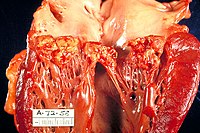
Photo from wikipedia
Staphylococcus aureus-induced infective endocarditis (IE) is a life-threatening disease. Differences in virulence between distinct S. aureus strains, which are partly based on the molecular mechanisms during bacterial adhesion, are not… Click to show full abstract
Staphylococcus aureus-induced infective endocarditis (IE) is a life-threatening disease. Differences in virulence between distinct S. aureus strains, which are partly based on the molecular mechanisms during bacterial adhesion, are not fully understood. Yet, distinct molecular or elemental patterns, occurring during specific steps in the adhesion process, may help to identify novel targets for accelerated diagnosis or improved treatment. Here, we use laser ablation inductively coupled plasma mass spectrometry (LA-ICP-MS) of post-mortem tissue slices of an established mouse model of IE to obtain fingerprints of element distributions in infected aortic valve tissue. Three S. aureus strains with different virulence due to deficiency in distinct adhesion molecules (fibronectin-binding protein A and staphylococcal protein A) were used to assess strain-specific patterns. Data analysis was performed by t-distributed stochastic neighbor embedding (t-SNE) of mass spectrometry imaging data, using manual reference tissue classification in histological specimens. This procedure allowed for obtaining distinct element patterns in infected tissue for all three bacterial strains and for comparing those to patterns observed in healthy mice or after sterile inflammation of the valve. In tissue from infected mice, increased concentrations of calcium, zinc, and magnesium were observed compared to noninfected mice. Between S. aureus strains, pronounced variations were observed for manganese. The presented approach is sensitive for detection of S. aureus infection. For strain-specific tissue characterization, however, further improvements such as establishing a database with elemental fingerprints may be required.
Journal Title: ACS infectious diseases
Year Published: 2022
Link to full text (if available)
Share on Social Media: Sign Up to like & get
recommendations!